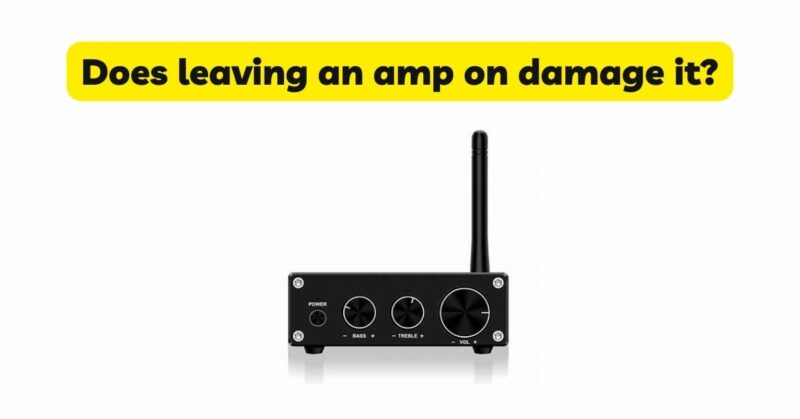The debate surrounding the potential damage caused by leaving an amplifier on continuously has long been a topic of discussion among audio enthusiasts. Some believe that leaving the amplifier on for extended periods can result in detrimental effects on its components and overall performance, while others argue that modern amplifiers are designed to handle continuous operation without adverse consequences. In this article, we will explore the question of whether leaving an amp on damages it, examining the factors at play and dispelling common misconceptions.
I. Understanding the Concerns:
- Heat Generation: Continuous operation can lead to increased heat generation within the amplifier, which may potentially affect the performance and lifespan of its components.
- Component Wear: Prolonged operation can contribute to component wear and reduce the overall lifespan of sensitive electronic parts, such as capacitors, transistors, and integrated circuits.
II. Examining Amplifier Design and Protection Mechanisms:
- Heat Dissipation: Modern amplifiers are designed with effective heat dissipation mechanisms, including heat sinks, cooling fans, and ventilation systems. These features help regulate temperature and prevent excessive heat buildup, mitigating the risk of component damage.
- Protection Circuitry: Most amplifiers incorporate built-in protection circuitry to safeguard against potential damage. These circuits monitor operating conditions and automatically shut down the amplifier if certain thresholds, such as temperature or current limits, are exceeded.
III. Heat and Component Longevity:
- Operating Temperature: While amplifiers generate heat during operation, manufacturers design them to operate within specific temperature ranges. As long as the amplifier remains within these prescribed limits, the likelihood of component damage is minimal.
- Continuous versus Intermittent Use: Continuous operation does contribute to heat accumulation, but it is important to note that excessive heat buildup is more likely to occur during intense usage periods, such as high-volume listening or driving demanding speaker loads, rather than continuous operation in itself.
IV. Practical Considerations:
- Heat Management: Ensure that the amplifier is placed in a well-ventilated area, away from sources of heat or confined spaces that restrict airflow. Adequate ventilation allows the amplifier to dissipate heat effectively, promoting optimal performance and component longevity.
- Power Cycling: Some audio enthusiasts prefer power cycling their amplifiers by turning them off when not in use. This practice reduces heat generation and gives the amplifier a period of rest, potentially prolonging the lifespan of its components. However, modern amplifiers are generally designed to handle continuous operation and do not necessarily require frequent power cycling.
- Manufacturer Recommendations: It is advisable to consult the manufacturer’s guidelines and recommendations regarding the appropriate usage and operational practices for your specific amplifier model. Manufacturers may provide specific instructions on power cycling, recommended operating temperatures, and any other considerations for optimal performance and longevity.
V. Myth Dispelled: The “24/7 Rule”:
- A common myth suggests that amplifiers should not be left on continuously for 24 hours a day, seven days a week, to prevent damage. However, this rule lacks scientific evidence and is primarily based on anecdotal experiences and personal beliefs.
- Properly designed and engineered amplifiers can handle continuous operation without significant risks of damage, as long as they are operated within their specified parameters.
VI. Conclusion:
Leaving an amplifier on continuously does not necessarily damage it, provided that the amplifier is well-designed, properly ventilated, and operated within its recommended temperature ranges. Modern amplifiers incorporate protection mechanisms to prevent excessive heat buildup and monitor operating conditions. While power cycling and following manufacturer recommendations can contribute to component longevity, the notion that leaving an amplifier on continuously will inevitably lead to damage is a myth. By understanding the design features, practicing appropriate heat management, and adhering to manufacturer guidelines, audio enthusiasts can enjoy their amplifiers with confidence, knowing that they are designed to handle continuous operation without adverse effects on performance or longevity.


